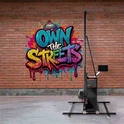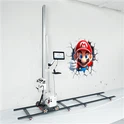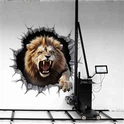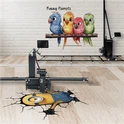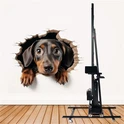Wall printing is revolutionizing large-format décor, custom murals, on-site branding, and specialty graphics, offering entrepreneurs a lucrative way to transform blank walls into stunning, high-value art. Whether you're a startup exploring new revenue streams or an established business in signage, interior design, or event planning, a wall printer (also known as a vertical wall printer, wall printing machine, or UV wall printer) can unlock significant profit potential. However, with models, printheads, inks, and service levels varying widely, choosing the wrong machine can lead to costly downtime, subpar results, and missed opportunities.
This comprehensive guide-crafted for beginners and seasoned entrepreneurs alike-walks you through the critical factors to evaluate, from budget and technology to portability, software, and after-sales support. By the end, you'll have a clear roadmap to select the best wall printer for your business and set yourself up for success in this booming market.
What Is a Wall Printer?
A wall printer is a specialized vertical inkjet system that digitally applies high-resolution images, logos, and artwork directly onto upright surfaces. Unlike traditional vinyl wraps or wall decals, wall printers eliminate the need for lamination, delivering vibrant, durable prints in hours. Supported substrates include:
- Interior walls(latex or acrylic paint)
- Exterior masonry (brick, concrete, stucco-with proper surface prep)
- Glass and metal (aluminum composite panels)
- Wood, MDF, and doors
- Ceramic tiles and other coated surfaces
Wall printers are designed for mobility, traveling to job sites and printing large-scale graphics section by section with precision motion control. Most use CMYK+White UV-curable inks, with optional white underbase for dark surfaces, ensuring versatility across projects.
Why businesses love them: Rapid on-site customization, high repeatability for chain retail rollouts, and premium perceived value for custom décor. From boutique cafés to corporate offices, wall printers create worthy murals that drive demand.
Why Invest in a Wall Printer? Market Demand and Profit Potential
The wall printing industry is thriving, fueled by a growing appetite for personalized décor. According to Grand View Research, the global digital printing market, including wall printers, is projected to grow at a 6.7% CAGR through 2030, driven by demand in residential, commercial, and hospitality sectors. In the U.S., the custom wall art market is valued in the billions, with entrepreneurs charging $100–$300 per square meter for wall prints.
Commercial opportunities include:
- Residential: Nursery murals, accent walls, or home office branding
- Commercial: Corporate logos, retail displays, or restaurant aesthetics
- Events: Photo backdrops for weddings, festivals, or trade shows
- Real estate: Staging properties with custom wall art to boost appeal
Real-world success: Many startups report six-figure revenues within a year by leveraging social media (e.g., Instagram) and niching down to specific markets like eco-friendly décor or corporate branding. A wall printer lets you start small with local clients and scale to national contracts with the right strategy.
Key Factors to Consider Before Buying a Wall Printer
To choose the right wall printer, you need to evaluate your business goals, budget, and operational needs. Here are the seven critical factors to guide your decision:
1. Total Investment Cost
The sticker price is just the start. A complete budget should include:
- Machine + shipping + taxes/import duties: Segment total budget. Decide where you will trade off: build quality, features or entry price.
- Consumables: Inks, cleaners, test media, and maintenance kits.
- Maintenance & service: Parts, labor, warranties, and calibration.
- Operating expenses: Transport to job sites, power usage, labor, and insurance.
- Hidden costs: Training, marketing, sample production, and downtime during the learning curve.
Pro Tip: Use a total cost of ownership (TCO) worksheet to forecast expenses. Request one from vendors like Tanyu or check our guide: How Much Does A Wall Printer Cost?.
2. What Drives Wall Printer Price?
Price variations stem from:
- Machine configuration: Modular vs. fixed-frame designs.
- Printhead type: Industrial-grade heads (e.g., Epson I3200, Ricoh) cost more but deliver superior results.
- Build quality: Durable materials and precision engineering increase longevity but raise costs.
Learn more: Wall Printer Price Factors.
3. Printhead Technology
The printhead is the heart of your wall printer, dictating resolution, ink compatibility, speed, and durability. Common options include:
- Epson DX7/DX10: Legacy heads, widely supported, cost-effective.
- Epson I1600/I3200: Newer, industrial-grade heads with finer droplet control for sharper prints.
- Ricoh industrial heads: Found in premium models like Wallpen, ideal for high-volume jobs.
Deep dive: Wall Printer Printhead Guide.
4. Print Quality Factors
High-quality wall prints depend on:
-
Ink quality: UV inks offer durability and vibrancy, especially with white ink for dark surfaces.
- RIP software: Processes images for accurate scaling, tiling, and color management.
- Control software: Ensures precise alignment and multi-pass printing.
- Waveform accuracy and machine stability: Prevents banding or misprints.
Poor-quality components or software can lead to inconsistent results, so prioritize trusted brands with proven track records.
5. Realistic Resolution (DPI)
Wall printers typically deliver 720 *1440 DPI or 1440*2880 DPI (interlaced), which is more than sufficient for murals viewed at typical wall distances. Resolution depends on the printhead's native nozzle pitch and the number of passes. Test sample wall prints to confirm clarity.
6. Print Speed
Real-world performance ranges from 2–6 m²/hour based on:
- Number of printheads
- Resolution settings
- Surface complexity
Faster isn't always better-high speeds can compromise quality. Balance speed with precision for professional results.
7. Maximum Printing Area
Most wall printers handle heights of 2–3 meters (6.5–10 ft) per setup. For taller graphics, look for:
-
Extended column options
- Wide clearance for large walls
- Minimal unprintable margins (contact us for check spec sheets)
Example: The Tanyu TMP1000 offers a modular design with a 3m height capacity, ideal for most indoor and outdoor jobs. See TMP1000 Portable Wall Printer.
Step-by-Step Guide to Choosing a Wall Printer
1. Define Your Budget and Business Scope
Your budget sets the foundation for your wall printer purchase. Beyond the wall machine's base price, factor in long-term costs to understand the total investment:
Machine cost+Consumables and maintenance+Additional expenses: Shipping, import duties, training, marketing, and transport logistics (e.g., fuel for mobile jobs).
Actionable Tip: Decide your target market-residential, commercial, or events-and choose a price tier that balances affordability with capability. For startups, entry-level model like Tanyu offers low-risk entry points. aiming for 3–6 months to break even with 3–5 jobs/week at $500–$1,000 each.
2. Source Directly from Reputable Manufacturers
Buying from established manufacturers ensures quality and support. Brand like Tanyu provides:
- Reliable parts supply: Direct access to printheads, inks, and components.
- Comprehensive training: Factory-led sessions on setup, operation, and maintenance.
- Warranty reliability: Faster resolution for repairs or replacements.
In contrast, third-party resellers may offer lower prices but often lack technical expertise or timely support.
Actionable Tip: Verify the vendor's credentials by requesting factory tour videos, customer testimonials, or a physical address. For example, Tanyu offers living demos and detailed spec sheets, ensuring transparency.
3. Prioritize Must-Have Features
The right features streamline operations and enhance print quality. Core features to look for include:
- White ink system: Essential for wall printing on dark or colored surfaces, with circulation/agitation to prevent clogging.
- Ink monitoring: Low-ink alerts to prevent mid-job interruptions.
- Temperature control: Heated ink systems for consistent flow, especially in colder climates.
- Automated maintenance: Self-cleaning or ink-extraction systems to reduce manual upkeep.
Optional upgrades, like dual printheads for faster output or extended masts for taller walls, may increase costs but boost efficiency for high-volume businesses.
Actionable Tip: Check the spec sheet to confirm which features are included versus add-ons. Contact us for more information on machine configurations and features.
4. Focus on Portability for Mobile Operations
Wall printing is inherently a mobile business, requiring machine that's easy to transport and set up. Key considerations:
Lightweight, modular design: Frames that disassemble for one- or two-person transport.
Quick assembly: Tool-free setup to save time on-site.
Compact storage: Protective cases or bags that fit in standard vans or SUV.
Cable management: Retractable or spring-loaded cables to avoid tripping hazards.
Example: The TMP1000 portable wall printer, highlighted on its product page, features a collapsible frame and travel kit that fits most car trunks, making it ideal for mobile muralists servicing homes or events.
Actionable Tip: Test portability by requesting a demo or video of the setup process. Ensure the wall printer's weight and dimensions suit your vehicle and crew size.
5. Evaluate Software for Seamless Workflow
A wall printer's software is critical for efficiency and precision. Look for:
- Dedicated Control Software: Tailored for vertical wall printing machine, unlike generic flatbed interfaces.
- RIP Software: Handles image scaling, tiling, and color calibration for accurate prints.
- Diagnostic tools: Error logs and remote troubleshooting to minimize downtime.
- User-friendly interface: Intuitive controls with multi-language support for your team.
Poor software can lead to misprints or slow training, as noted in user feedback on Reddit's r/printing community, budget models often ship with clunky, untranslated interfaces.
Actionable Tip: Request a software demo or trial access. Brand like Tanyu has advanced RIP software.
6. Consider Customization for Brand Differentiation
Custom features can set your business apart in competitive markets:
- Branded aesthetics: Custom machine colors or logo wraps for a professional look.
- Extended capabilities: Upgraded masts for taller prints or wider clearance for large walls.
- Printhead options: Dual or industrial-grade heads for faster, sharper output.
- Localized UI: Software in your team's native language for faster training.
Actionable Tip: Discuss customization with wall printer manufacturers early to understand costs and lead times. For example, Tanyu offers bespoke machine designs for branding, ideal for corporate clients.
7. Secure Robust After-Sales Support
Your wall printer's long-term success depends on reliable support. Prioritize vendors offering:
- Technical assistance: 24/7 remote support, with clear response times for your region (U.S., Canada, EU, Australia).
- Training resources: Multi-language manuals, video tutorials, and online workshops.
- Marketing tools: Sample artwork libraries or templates to pitch clients.
- Community access: User forums or WhatsApp groups for peer advice.
- Parts availability: Fast shipping for inks, printheads, and components.
Actionable Tip: Ask vendors for support, customer satisfaction metrics, and references from existing users.
Profitability and ROI: Crunching the Numbers
Wall printing offers 60–90% profit margins due to low material costs (inks cost pennies per square foot) and high perceived value. Here's how to maximize ROI:
- Pricing models:
Per square foot: $20–$30 for simple designs, $50+ for complex murals.
Packages: "Full Room Makeover" for $1,000–$5,000.
Hourly rates: $100–$200/hour plus materials.
- Break-even example: A $10,000 printer pays for itself after 20–30 jobs at $500 each. Aim for 3–5 jobs/month to profit within 6–12 months.
- Cost-saving tip: Choose models with low ink consumption (up to 50% savings, like Tanyu).
Bundle design services (e.g., mockups via Canva) to upsell and boost margins.
Pros and Cons of Wall Printing
Pros
- High margins: 60–90% profit per job.
- Creative freedom: Print any image at up to 2880 DPI .
- Scalability: Start solo, then expand to a team or franchise.
- Mobility: Modular wall printers fit in vans or car for on-site jobs.
Cons (and Solutions)
- Learning curve: Setup and maintenance take 1–2 weeks to master.
Solution: Leverage manufacturer training videos and practice on test media.
- Competition: Saturated markets require differentiation.
Solution: Niche down (e.g., eco-friendly inks) and build a portfolio on Instagram.
Evidence:User reviews on Quora highlight ROI within months for quality investments.
Actionable Steps to Get Started
1. Define Your Needs: Low-volume starter? or High-volume goals?
2. Research Features: Prioritize speed (e.g., 2–6 sqm/hour), ink type (UV for versatility), and software for design uploads.
3. Compare Models:Contact us for request demos.
4. Start Small, Scale Smart: Book local gigs via social media. Reinvest profits into a second printer or staff training to double revenue annually.
Ready to Transform Walls into Profits?
Wall printing isn't just a machine purchase-it's a gateway to a creative, high-margin business. With booming demand, flexible pricing, and the right equipment, you can turn blank walls into a thriving enterprise. Start by exploring trusted suppliers like Tanyu for demos and pricing. Need help comparing models or calculating ROI? Contact our team for:
- Live demo wall prints
- Total cost of ownership worksheets
- Starter kits and training programs
Take the next step: Reach out to Tanyu or a regional distributor to start your wall printing journey. Let's turn your vision into reality-contact us today!

